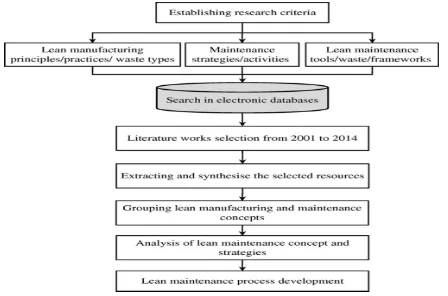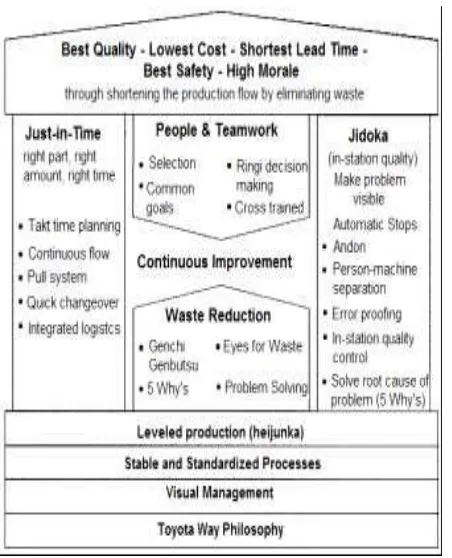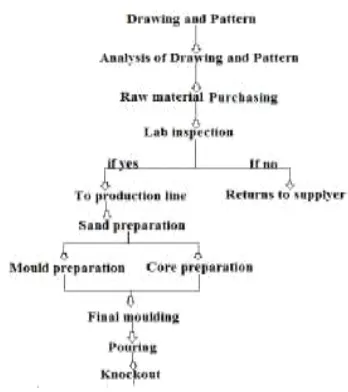IJIRT 145294
INTERNATIONAL JO URNAL OF INNOVATIVE RESEARCH IN TECHNOLOGY419
Lean Manufacturing Application in Foundry Industry - A
Review
Tushar P. Jaiswal
1, Dr. Rajendra S. Dalu
21
M. Tech. (Production Engineering) Scholar, Government Co llege of Engineering, Amravati
Maharashtra, India
2
Associate Professor, Department of Mechanical Engineering, Government College of Engineering,
Amravati , Maharashtra, India
Abstract- The S teel Alloys foundry industry, small to medium sized IS O 9001:2000 Certified Manufacturing
plant, has a difficulty of implementing and
improvements in its internal logistics systems and All Manufacturing S teel Alloys Industry it has to put in continuous efforts for it's survival in the current impulsive and competitive economy in the industry.
Lean manufacturing (LM) is seen as major
breakthrough process and It is widely used by major industries all over the world. The LM is Complex and benefice but possible changes can bring ergonomically issues and demarcated as a manufacturing system that concentrating continuous flow within supply chain by removing all wastes and execution continuous development towards product excellence.This industries are adopting new tools and techniques to produce goods to complete and survive in the market and This paper addressed the various production processes that can be used in S mall scale foundry, finding the problems existing in these processes and implementing the various Lean Manufacturing tools and analyzing the result on Current Trends in Lean Management. This paper will further assist the organization to improve it's manufacturing process and Align it to the requirements of it's customers and contribution to manufacturing
sector to enhance productivity, quality and
competitiveness is immense.
Index Terms- S mall scale foundry, production
processes, problems identified, lean manufacturing tools and analysis.
I. INTRODUCTION
Steel Alloys foundry is an In the current era of globalization industries are adopting new tools and techniques to produce goods to complete and survive in the market and supplier engaged in the Manufacturing of world class CI Castings including
Pulleys, Fly Wheels, Housings, Casings, Ginning Parts, etc. Lean manufacturing (LM) is seen as an important tool used across the industries in the recent scenario.
At present the industries are facing a higher level of competition because of the globalization major breakthrough process and Lean manufacturing provides a new management approach for many small and medium size manufactures, especially old firms organised and managed by under traditional push systems. Improvement results can be dramatic in terms of quality, cycle times, and customer responsiveness which is more than a set of tools and techniques and has been widely adopted by many production companies.and is widely used by major industries all over the world. In a continuous process industry like casting the main approach of implementing the lean manufacturing is to reduce the production cost by eliminating the non-value added activities. In a recent survey, approximately 36% of US- based manufacturing companies have implemented lean or are in the process of implementing lean. An LM facility is capable of producing product in only the sum of its value added work content time.
The significance of a LM model include: production of only one unit at a time; non-value added time eliminated; production of the job within time pre decided; relocation of required resources to the point of usage; and all processes must be completed within the time as scheduled. Lean Manufacturing technique has a great importance with Indian small scale Industries.
IJIRT 145294
INTERNATIONAL JO URNAL OF INNOVATIVE RESEARCH IN TECHNOLOGY420
manufacturing is an important tool used across the industries in the recent scenario. At present the industries are facing a higher level of competition because of the globalization. In this context, to remain and compete in the market, companies need to deploy certain tools and techniques which are useful to the uplift their performance and to respond rapidly to the customer„s needs. The fundamental concept of lean manufacturing is to provide a quality product while also ensuring that the product does not cost too much to the customer. There are number of production processes carried out by various machines at various departments in small scale foundry and I studying and analyzing these production processes to finding the problems if any facing by the industry.
2. RESEARCH METHODOLOGY
The purpose of this study is the application of various lean manufacturing tools in small to medium sized foundry industry.
The main steps of work:
Study of production processes in a small scale foundry.
Identification of problems arising in the foundry.
Analyzing the various causes of problems.
Implementing the various lean manufacturing tools
Observation table about production rate
Result of measurement.
The primary aim of this study is to find out the needs and examine the degree to which the concepts of lean management are put into practice within various manufacturing Industry:
(i) This is an overview for finding the current situation of lean management practices in manufacturing industries.
(ii) It is a measure to identify the constrains that retains lean manufacturing in the infant stage in manufacturing firms and The constraint that predict the implementation and sustainability of lean manufacturing tools and techniques are also discussed.
Fig. 1 Research Methodology Framework
3. LITERATURE REVIEW
A detailed review of research in current trend of lean management in various manufacturing industry like automotive industry, machine tool industry, semi-process industry, electronics manufacturing industry, steel industry, pump industry and furnishing industry has been discussed. Lean manufacturing is a multi-dimensional management practice including just in time-quality systems, work teams, cellular manufacturing, supplier management etc. the popular definition of Lean Manufacturing and the Toyota Production System usually consists of the following, Wilson (2009).
• It is a comprehensive set of techniques which when combined allows you to reduce and eliminate the wastes. This will make the company leaner, more flexible and more responsive by reducing waste.
• Lean is the systematic approach to identifying and eliminating waste through continuous improvement by flowing the product or service at the pull of your customer in pursuit of perfection.
IJIRT 145294
INTERNATIONAL JO URNAL OF INNOVATIVE RESEARCH IN TECHNOLOGY421
Chaple(2014) investigate the enablers and barriersin implementing the Lean principles and lean diffusion in Indian manufacturing industries. Result show that the trend in lean manufacturing for research now is focused on lean assessment. Leanness attracts focus to answer specific questions of different levels of managers responsible for lean implementation to assess the lean implementation level and to justify spending over lean implementation. He worked on multiple criterion decision-making (MCDM) for lean assessment to assess lean performance holistically & popularity of lean in India; but when it comes to success, its only start of journey.
AzharulKarim et al( 2013) conducted a research todevelop an effective methodology for implementing lean manufacturing strategies and a leanness, following are the methodology are adopted for the present study they are Production and process details, Lean team study, Performance variables. VSM and MTM together and offered a new approach to reduce lead time and to measure productivity based on Lean principle and standardized processes.
GulshanChauhan et al( 2012) research depictsabout, Elimination of waste, JIT, and CI. Driving parameters towards LM are vertical information system, integration of functions, decentralization, multifunctional teams, Pull, JIT deliveries, zero defects, CI and Elimination of waste. JIT is top priority, then CI. He follows SPSS correlation method to find the importance of implementation.
George L. Hodge et al(2011) conducted a researchto identify lean tool for textile industries to eliminate waste and non-value added activities in US to enhance the customer satisfaction, Author identified the following barriers for implementing lean manufacturing they are resistance to change both shop floor employees and management; shop floor employees are reluctant to offer suggestions for improvements; disconnect among marketing, sales, product and development; shop floor personnel are not native English speakers; so training needs to be multilingual.
NordinNorani et al(2010) research identified the,main reason for failure of implementation of Lean manufacturing is due to the letdown in managing the
change process during a lean manufacturing transformation, organizational change management. Serve as the basis for further empirical research and validation. Provide practitioners with a better understanding of lean transition and unambiguous guidance, and/or tools to minimize the resistance and conflicts of implementing a lean manufacturing system. In the present research 11 critical factors were studied, and proposed framework of organizational change is intended to provide practitioners with a better understanding of the lean transition and a clear guidance to minimize the resistance and conflicts for the implementation of lean and thus improves its chance of success.
3.1 LEAN PRODUCTION SYSTEM
Lander and Liker (2007) discussed the performance benefits of lean systems are often remarkable, greatly improving quality, cost, and delivery and studied the fundamental misunderstanding of TPS, viewing it as a specific tool kit technically implemented in a formulaic way to achieve pre-specified results. According to Shah and Ward (2007) lean production is a multi-dimensional approach that encompasses a wide variety of management practices, including just in time, quality system, work teams, cellular manufacturing and supplier management in an integrated system.
Petersen (2003) in his article made the analysis of the lean literature and concluded that among the authors dominates a view that lean is more than a set of tools, since it is a philosophical approach to lean. Therefore, lean production is also considered as a philosophy of continuous improvements and respect to people.
3.2 HOUSE OF LEAN
Liker (2003) illustrated the most common lean tools in the form of house as shown in Figure 1. The goal of lean production is set in the roof and consists of reaching for the best quality, lowest costs, shortest lead-time, highest safety and high morale. The left pillar encloses Just-in-Time principle that consists of production planning and levelling tools like tact time, continuous flow, pull system, quick changeover and integrated logistics.
IJIRT 145294
INTERNATIONAL JO URNAL OF INNOVATIVE RESEARCH IN TECHNOLOGY422
from machines. People are in the centre of the lean house concept since people see waste and solve problems that lead to continuously improvement of the processes.
In addition, it is important to consider the characteristic of a lean work organization since the responsibilities are decentralized to multifunctional teams. The foundation of the house has to be stable for the pillars to stand steadily and consists of the tools like 5S, standardized work and leveled production.
Fig. 2 Lean House
3.3 LEAN WASTES
According to David Magee (2007), different kinds of wastes in a process are categorized in following categories.
Overproduction – Producing items more than required at given point of time i.e. producing items without actual orders creating the excess of inventories, which needs excess staffs, storage area as well as transportation etc.
Waiting – Workers waiting for raw material, the machine or information etc. are known as waiting and is the waste of productive time.
Unnecessary Transport – Carrying of Work in Process Inventory (WIP) a long distance, insufficient transport, moving material from one place to another place is known as the unnecessary transport.
Over processing – working on a product, more than the actual requirements is termed as over processing.
Excess Inventory - This includes excess raw material, WIP or finished goods causing longer lead times, obsolescence, damaged goods, transportation and storage costs, and delay. In addition, the extra inventory hides problems such as production imbalances, late deliveries from suppliers, defects, equipment downtime, and long setup times.
Unnecessary Motion – Any wasted motion that the workers have to perform during their work is termed as unnecessary movement.
Defects – Defects in the processed parts is termed as waste. Repairing defective parts or producing defective parts or replacing the parts due to poor quality etc. is the waste of time and effort.
Unused Employee Creativity – Loosing of getting better ideas, improvement, skills and learning opportunities by avoiding the presence of employee is termed as unused employee creativity.
3.4 ESSENTIAL LEAN MANAGEMENT TOOLS Vorne (2012) discussed the most important lean management tools such as 5S, Andon, Bottleneck Analysis, Continuous Flow, Gemba, Heijunka, HoshinKanri, Jidoka, Just-In-Time, Kaizen, Kanban, KPI, Overall Equipment Effectiveness, PDCA, Poka-Yoke, Root Cause Analysis, Single Minute Exchange of Die (SMED), Six Big Losses, SMART Goals, Standardized Work, Takt Time, Total Productive Maintenance, Value Stream Mapping and Visual Factory used for productivity improvement in manufacturing indus tries.
3.5LEAN PRACTICES IN VARIOUS
MANUFACTURING INDUSTRIES
In recent years, a plethora of literature has
IJIRT 145294
INTERNATIONAL JO URNAL OF INNOVATIVE RESEARCH IN TECHNOLOGY423
implementation of lean philosophy into various manufacturing sectors.
Eswaramoorthi et al, (2011) discussed the current status of lean implementation in Indian machine tool industries as well as tinted some allied issues. The survey has attempted to formulate simple questionnaire based tool to identify the existing level of lean practices, reasons for inadequate priority to lean concepts, type of lean tools employed, perceived level of different wastes, and the common difficulties encountered by the Indian Machine tool Manufacturers. The survey results revealed that 31,6% of the companies have implemented different lean tools and techniques in selected areas. The remaining 68,4% of the companies have not yet taken up the lean initiatives.
Implementation is also snail-paced, and it has a further scope to develop focused lean concepts, which could be implemented in other kind of manufacturing environment like low volume and high variety. It is concluded that the major reasons for low level of lean implementation are anxiety in changing the mind-set of workers, lack of awareness and training about the lean concepts and cost and time involved in lean management implementation. Therefore, the machine tool manufacturing companies need to give attention to implement lean in all the key areas from a holistic perspective.
4. CHALLENGES IN LEAN IMPLEMENTATION AND SUSTAINABILITY
The challenges faced in the process of implementing and sustain lean is a tedious job as the concept relates to time, cost, interest, and involvement, the concepts that together support the new change for development in an firm. The study tells that new firms introduce and accept lean manufacturing and other innovative concepts than the old and existing firms. The forces opposing and driving a change to lean is shown in Figure 2.The following important factor of resistance to change in manufacturing sectors is
Fear to change the legacy system with the new successful trends and methodologies
Not utilizing the opportunities and advantages of the new policies
Market destabilization will lead to force the change, which will be in a non-standard format.
Fig. 3 The forces opposing and driving a change to „lean‟
4.1 PRODUCTION PROCESSES FLOWCHART
Fig. 4 The Production Processes Flowchart
5. PROBLEM IDENTIFIED IN FOUNDRY
IJIRT 145294
INTERNATIONAL JO URNAL OF INNOVATIVE RESEARCH IN TECHNOLOGY424
6. CAUSES OF PROBLEM
Raw materials hostage.
Man power problems.
Breakdowns.
Assembly line problems
6.1 LEAN MANUFACTURING TOOLS HAVE BEEN IMPLEMENTED IN FOUNDRY:
Kaizen (Japanese for “improvement” or “change for the better”)–A strategy where employees work together proactively to achieve regular, incremental improvements in the manufacturing processes.
Kanban (Japanese for “signboard” or
“billboard”, which is a scheduling system for just-in-time JIT production)-A method of regulating the flow of goods both within the factory and outside suppliers and customers. Based on automatic replenishment through signal cards that indicate when more goods are needed.
5S (the name of a workplace organization method based on five Japanese words: seiri, seiton, seiso, seiketsu, and shitsuke,translated into English as sort, set in order, shine, standardize and sustain).
Benchmarking (standardized work)-Eliminates waste by consistently applying best practices. Forms a baseline or future improvement activities.
Total Productive Maintenance-Creates a shared responsibility for equipment that encourages greater involvement by plant floor workers. In the right environment this can be very effective in improving productivity (increasing up time, reducing cycle times and eliminating defects)
Single Minute Exchange of Die-Enables manufacturing in smaller lots, reduces inventory, and improves customer responsiveness.
Six big losses- Six categories of productivity loss that are almost universally experienced in manufacturing: Breakdowns, setup/adjustments, small stops, reduced speed, start up rejects and production rejects.
6.2 USAGE OF LEAN MANUFACTURING
TOOLS
Fig. 4 The Uses Of Lean Manufacturing Tools It is visible that the 5S system is the most popular. It is also the simplest and often a no-cost approach.
6.3 5S STANDS FOR-
Set in order (organize remainingitems)
Shine (clean and inspect workarea)
Sort (eliminate that which is notneeded)
Standardize (write standards forabove)
Sustain (regularly apply thestandards)
That is it eliminates waste that results from a poorly organized work area.(e.g. wasting time looking for a tool)
7. CONCLUSIONS
In India small and medium scale industries play a very important role in Indian economy expected outcome of the analysis is to focus on the production rate at small to medium foundry industry. After analyzing the five months data of the foundry industry, in the second month when the demand rate is 510tons/month, planned rate is 560tons/month and production rate is 458 tons/month then greatest production and delivery efficiency is obtained. Because there is less shortage of raw material in inventory management department, Proper precautions are taken to reduce number of breakdowns and Proper sequencing of workstations are done to reduce assembly line problems to certain level.
REFERENCES
IJIRT 145294
INTERNATIONAL JO URNAL OF INNOVATIVE RESEARCH IN TECHNOLOGY425
manufacturing implementation, Vol. 3 No. 2, pp. 77-85.
[2] Shah, R. and Ward, P.T.(2009), Lean manufacturing: context, practice bundles, and
performance, Journal of Operations
Management, Vol. 21, pp.129-149.
[3] Billesbach,T. et.al (2009), Applying lean production principles to a process facility, Production and Inventory Management Journal. p. 5-25.
[4] A Study of Auto Pour in Sand Casting Process Applied Mechanics and Materials Vol 660 (2014) pp 74-78 (2014) Trans Tech Publications, Switzerland.


